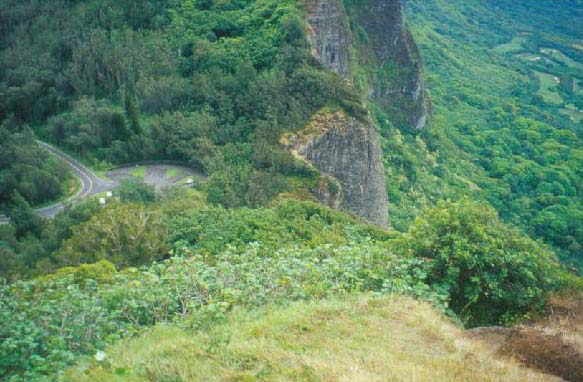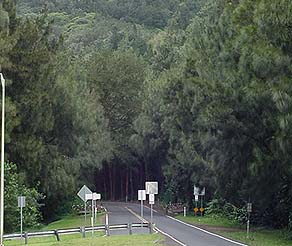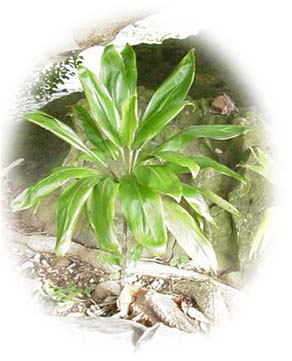 |
 |
 |
|||||||||||||||||||||
|
|
|
|
|
|
|
|
|
||||||||||||||||
|
|
|||||||||||||||||||||||
|
|
|
|
At the Pali lookout.
|
|
"There are many stories connected with the Pali," says Kalani. "Stories about seeing Pele on the highway there, or a white dog which is another image or vision associated with Pele. Kamapua'a in stories of not to carry pig over the Pali. All of which I grew up with and we all followed. We never went over the Pali with any pork in the car. We still don’t -- that I can tell you. "I know that there is a story that Kamapua‘a--the famous pig god--was there, and that he would frequent the Nu‘uana area. He was known as a trickster. He would make a human appearance or a pua‘a appearance and you needed to be on your guard or wary so you did not do anything that was going to cause him to do any mischief with you in the area."
|
||
|
|
||
|
"The area is secluded. People go there to be alone and have things happen to them, noises in the night. I think they are doing mischief and it brings on the mischief. It depends on what type of business you are doing. If it’s not totally up-and-up, then you probably shouldn’t be there anyway. "I have found that it is a very basic rule in our Hawaiian culture: if you are doing something that is not your business to do, or that is inappropriate, there will be mischief or an undoing come of it, so you probably shouldn’t be doing it anyway."
|
|
|
|
"Nu‘uanu is a different environment to grow up in. So many today have neighborhoods and they have parks, and they have tennis courts, or basketball courts, or volleyball courts. Whereas, if you grew up in Nuuanu Valley, you played in the backyard, which was the forest and the stream. You went swimming in the streams first before the ocean. We learned where all the ponds were coming down through the streams. "We spent our weekends or afternoons running through the forest picking guava, mountain apple and floating down the streams in tubes or stream hopping. Swimming all the way down. There are different ponds with different falls. We would go there and spend the day just playing in the ponds. "We always went through the forest simply by following the stream. We never came out on the road from any of our 'playground' areas, which were basically from Queen Emma's on up. The homes all slope down and border on the river, and every homeowner took care of those pond areas. All of us as kids knew this, and they knew who we were. If we misbehaved they certainly knew how to get ahold of our parents because we didn’t really have many people who lived up in this area, and the Nu‘uanu families that had lived here for many generations knew each other."
|
|
"Ti leaf siding was further up the mountain at the Dowsett highland area, where there was tall grass after the pineapple, and now that there are more homes built there you’d have to go further up. But the ti-leaf sliding was in that area. "You needed that tall grass, when it was wet, to go ti leaf sliding. You would go up, find your favorite spot, and usually there were ti leaf plants all along the way. Everyone would gather 6 or 8 or 10 bunches of ti leaves that might make a good cushion, and they were wet. "You start at the top. You sit on them and you push, holding the stems in front of you between the legs. And you’d push, and it might be rough going for the first one, but as soon as there was a trail laid, it would get damp, and then it would get very slippery. And at the bottom, when we were all tired, then we’d go swimming."
|
|
|
|
|
|
"When I was little, I used to get perplexed about, you go to First or Second Grade, you would read these readers, 'see Spot run, see Dick and Jane chase Spot…' And I really had a reader like that in First Grade, and I was puzzled by it. I sat there, listened to teacher who was from America -- called 'the Mainland' -- and read these things. "Then we would come home and we’d do our valley things with my cousins who lived next door. We were very family-oriented. I would walk to their house, two or three houses up the road, they’d come down, we’d go out and gather guava so my mother could make fresh guava juice, when it was season. "One day my mother was out at the stream, the auwai, probably clearing it. I forget what subject had been going on in school, but I came out and I stood there and I saw my mother kneeing at the water and I said, 'Are we Indians?' And she said, 'No, we are Hawaiians.' 'Well, why do they talk about the Indians being the first people in the land?' And she said, 'Well, they’re not.' And I thought, But why? Why am I reading about Indians, and Dick and Jane and Spot and all that, when we are Hawaiians here? "That has stuck with me since I was about six years old. I knew the answer then and of course I know the answer now . I articulate it differently now than I did then. That is something, why we were taught someone else's history, pretending that it was our history, when it was not."
|
||
|
|
||
|
|
"My family always retained a sense of the old, cultural protocal. So many felt that it was a negative to be Hawaiian, but we never felt that way. And I didn’t realize it until I was older and an adult, and had come back from school in America, (or 'the Mainland' as we called it then), about all these customs that went on in my family. "My grandmother would speak to us in Hawaiian, and in the house: Hawaiian. And we didn’t pay attention, as so many kids don’t, and run off, and come back, and we knew what she was saying, but we didn’t answer her in Hawaiian. All too frequently, when she did speak to us it would be in Hawaiian. The house was always quiet, because again it was being mindful and respectful, and she was teaching us her ways. "We would either respond to her non-verbally, using a kind of mental telepathy, or we would answer with yes or no, or whatever the appropriate English word was, and then scoot out. Not knowing of course that it was going to be fleeting -- in more ways than one -- and that we would have wished we had learned to speak Hawaiian then. She knew, but as is the case with somebody older who is teaching a younger person, there’s just no way to get them to know that, until they know that."
|
|
|
|
|
One major change that Kalani saw affecting Nu‘uanu in her lifetime was the construction of the Pali Highway.
|
||
|
|
||
| |
| |
|
|
 |
| Nu‘uanu Home | Map Library | Site Map | Hawaiian Islands Home | Pacific Worlds Home |
|
|
|||
| Copyright 2003 Pacific Worlds & Associates • Usage Policy • Webmaster |
|||









